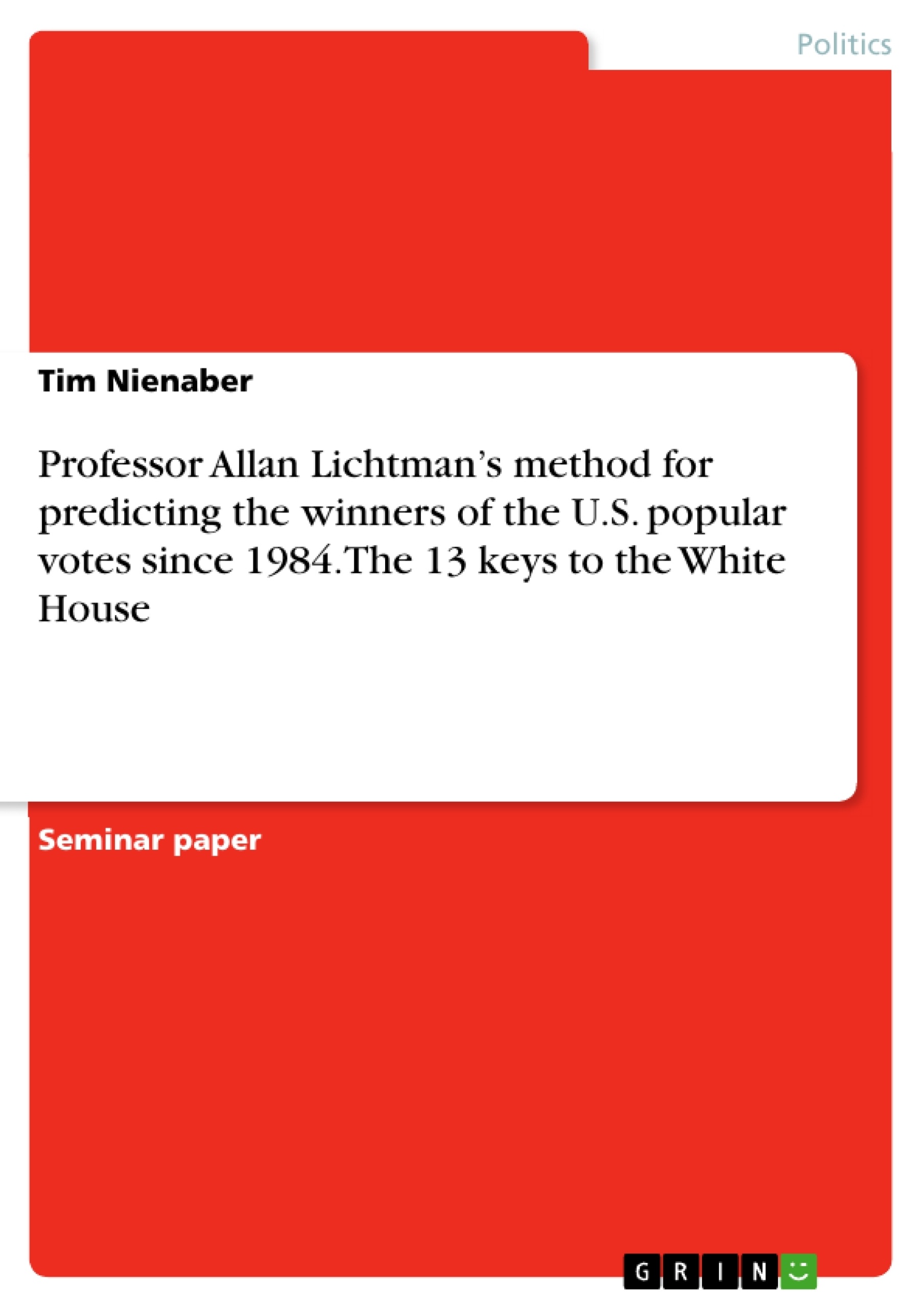This paper will focus on what Lichtman calls the "Thirteen Keys to the White House" and how he used them to predict the outcomes of the last nine presidential elections. To do so, his book "The Keys to the White House" which was firstly published in 1996 is required as the main source for the following steps that will serve as the leading topics of each chapter of this paper.
The first chapter will briefly summarize and explain Lichtman’s thirteen keys and how they were determined as critical indicators for predicting the winner of a presidential election. In a second step and therefore in the second chapter the focus will lie on how Lichtman decided whether a key applied to a residing President or not, especially regarding certain keys which cannot be answered simply because of extraordinary circumstances surrounding particular candidates of the various presidential elections since 1984. As Lichtman stated that the presidential race between Republican candidate Donald J. Trump and Democratic candidate and former First Lady of the United States Hillary Clinton was the hardest election to predict, a third chapter will focus on the reasons for that. Additionally, the chapter will try to apply the keys to a new election by assuming that Donald Trump will run for office again.
Inhaltsverzeichnis (Table of Contents)
- Introduction
- Allan J. Lichtman's Thirteen Keys to the White House
- Applying the thirteen keys to different candidates and elections
- Ronald Reagan versus Jimmy Carter in 1980
- Carter's presidency and his starting position
- Reagan's Hollywood charisma versus Carter's scandals
- Third-party and Republican challengers
- George W. Bush's successful reelection in 2004
- Bush's military actions before and after 9/11
- Torture and inertia
- Bush claims the political keys one to four
- John Kerry and George W. Bush – two uncharismatic candidates
- Turning the keys to the White House 2016: Trump & Clinton
- An empty office: The democratic situation post-Obama
- The remaining keys
- The fourth key - Lichtman's error
- Ronald Reagan versus Jimmy Carter in 1980
- Conclusion
Zielsetzung und Themenschwerpunkte (Objectives and Key Themes)
This paper aims to analyze Allan J. Lichtman's Thirteen Keys to the White House method for predicting the winners of U.S. presidential elections. It examines the methodology, application, and effectiveness of this system by exploring its use in predicting past elections, particularly those of 1980 and 2004.
- Predicting U.S. Presidential Elections
- The Thirteen Keys System
- Application of the Keys in Specific Elections
- Governmental Performance as a Predictor of Election Outcomes
- Charisma and its Influence on Presidential Elections
Zusammenfassung der Kapitel (Chapter Summaries)
The first chapter introduces the Thirteen Keys to the White House developed by Allan J. Lichtman, highlighting their significance as indicators for predicting presidential election outcomes. It explains the methodology behind the keys and their focus on governance rather than campaign strategies or candidate personalities. The second chapter explores the application of the thirteen keys to specific presidential elections, focusing on how Lichtman assessed their relevance to each candidate and election. It analyzes the reasons behind the loss of Jimmy Carter in the 1980 election against Ronald Reagan, considering factors such as Carter's presidency and the rise of Reagan's charisma.
The third chapter delves into the analysis of George W. Bush's successful reelection in 2004. It explores how the keys were applied to Bush's presidency and analyzes the significance of factors like his military actions, controversies surrounding his administration, and the comparative charisma of the candidates.
Schlüsselwörter (Keywords)
The paper focuses on the Thirteen Keys to the White House method, U.S. presidential elections, political science, election predictions, governance, charisma, incumbent advantage, campaign strategies, economic indicators, foreign policy, and social unrest. It examines the applicability of the keys system to various historical elections, including those of Ronald Reagan in 1980 and George W. Bush in 2004.
- Quote paper
- Tim Nienaber (Author), 2020, Professor Allan Lichtman’s method for predicting the winners of the U.S. popular votes since 1984. The 13 keys to the White House, Munich, GRIN Verlag, https://www.grin.com/document/703193



